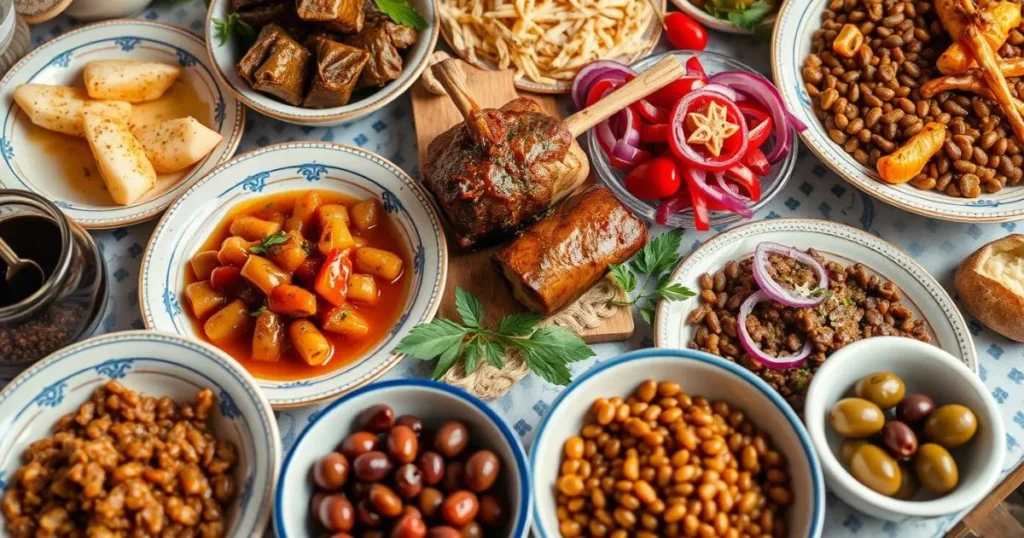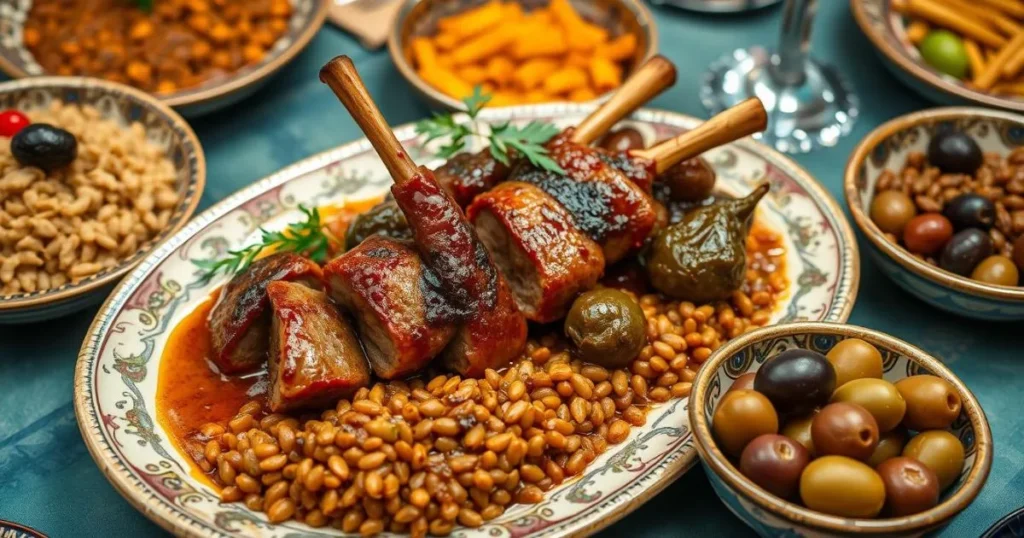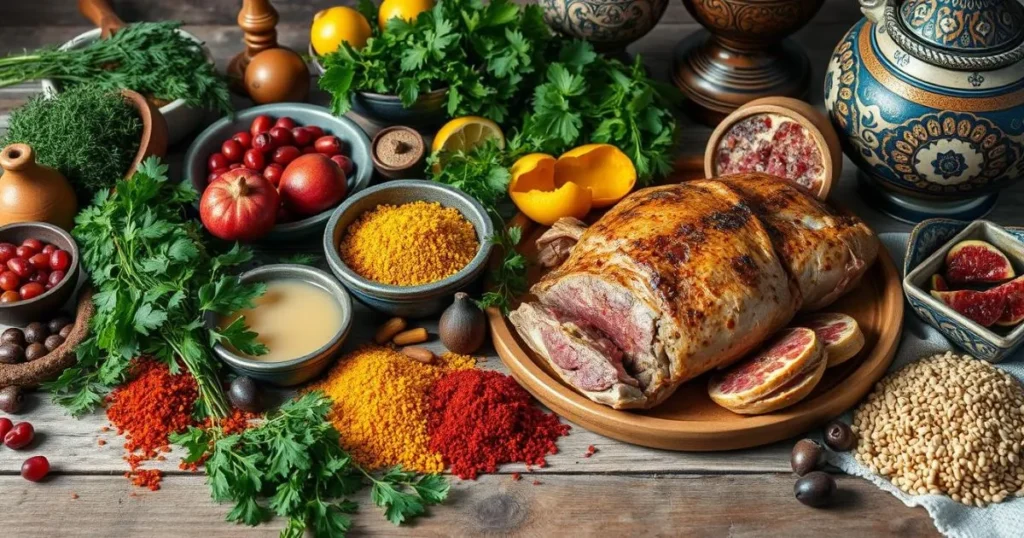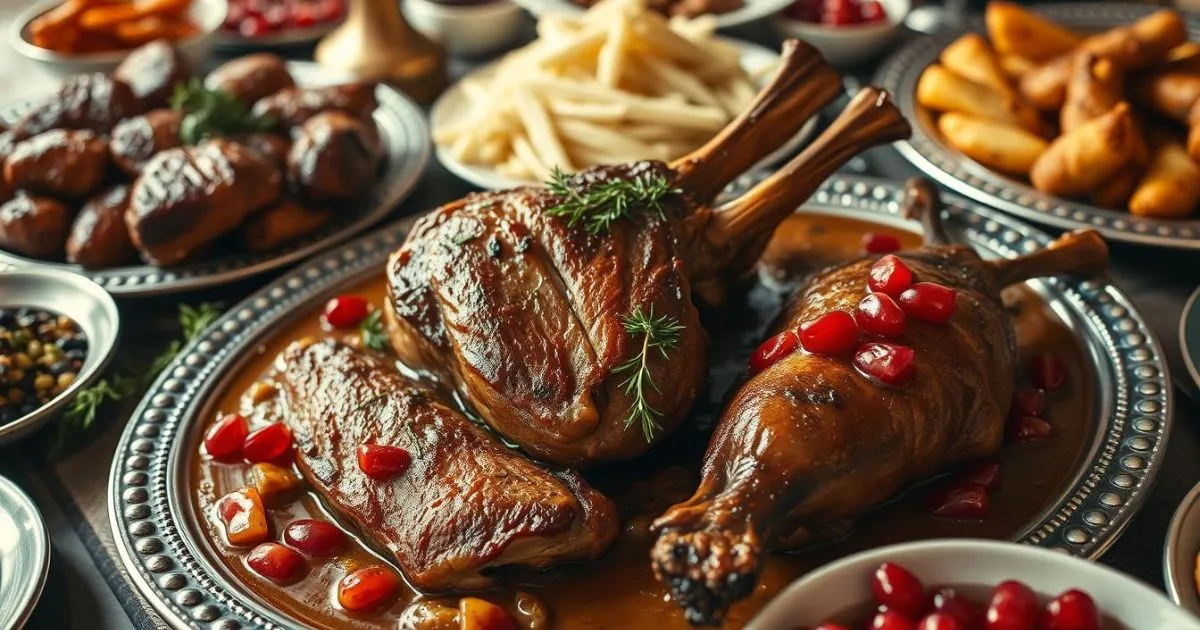recipes from the byzantine empire
Table of Contents
Ever wondered about the tasty dishes from the Byzantine Empire? Let’s travel back in time together. We’ll explore the delicious world of Constantinople’s kitchens. From royal courts to marketplaces, get ready to be amazed by Byzantine flavors.
The Culinary Heritage of Constantinople’s Royal Kitchens
Step into the lavish world of Constantinople’s imperial courts. Here, the culinary heritage of the Byzantine Empire was forged. The Imperial Court had elaborate dining traditions, blending ancient East flavors with Mediterranean finesse.
At the heart of this tapestry was Empress Theodora. Her Persian and Indian cooks left a lasting mark on Byzantine cuisine.
Imperial Court Dining Traditions
The Byzantine elite enjoyed sumptuous three-course meals. These started with hors d’oeuvres, followed by a main course of fish or meat. The meals ended with a sweet finale.
This opulent dining was a showcase of the empire’s historical cooking and culinary heritage. In contrast, the common people and middle classes had simpler fare. Their meals often featured eastern roman empire recipes and constantinople food.recipes from the byzantine empire
Influence of Empress Theodora’s Persian and Indian Cooks
Theodora, the influential empress, brought talented cooks from Persia, India, Syria, and Greece. These cooks introduced new spices, techniques, and flavors. They enriched the historical cooking and culinary heritage of Constantinople’s royal kitchens.
Daily Meal Structure in Byzantine Times
The Byzantine daily meal structure had three parts: breakfast, midday, and supper. Fasting days were also common, as the devout population followed religious dietary restrictions.
This balance of feasting and fasting highlighted the deep eastern roman empire recipes and constantinople food traditions. These traditions defined the Byzantine culinary landscape.

Essential Ingredients in Byzantine Cooking
Travel back in time to the Byzantine Empire’s kitchens. They were filled with a wide range of ingredients that excited the senses. From the Mediterranean coast to the fertile lands, cooks had access to many foods, meats, and spices. These ingredients created the distinct tastes of Byzantine dishes.
Meats were key, with pork, fowl, and seafood leading the way. The coastlines offered plenty of fish and shellfish. Meanwhile, the lands provided cheeses, fruits, and nuts. Apples, melons, dates, figs, grapes, and pomegranates were common, along with almonds, walnuts, and pistachios.
The Byzantine kitchen also valued vegetables. A variety of greens, roots, and legumes were used in stews, soups, and sides. Olive oil, essential to the Mediterranean, was a staple. Honey, sweet and versatile, was used in both savory and sweet dishes.
Spices were crucial in Byzantine cooking. Cinnamon, sumac, and garum (fermented fish sauce) added depth. Trade with the Arab world introduced saffron, cloves, and nutmeg, enriching Byzantine flavors.
If you love mediterranean recipes, study edible history, or just enjoy trying new things, Byzantine cuisine is fascinating. It offers a peek into the byzantine cuisine that influenced ancient flavors.
| Ingredient Category | Examples |
|---|---|
| Meats | Pork, Fowl, Fresh Seafood |
| Produce | Apples, Melons, Dates, Figs, Grapes, Pomegranates, Almonds, Walnuts, Pistachios |
| Vegetables | Greens, Roots, Legumes |
| Dairy | Cheeses |
| Oils and Sweeteners | Olive Oil, Honey |
| Spices and Condiments | Cinnamon, Sumac, Garum (Fermented Fish Sauce), Saffron, Cloves, Nutmeg |
“The Byzantine Empire’s culinary heritage was a tapestry of flavors, woven together by the diverse ingredients and influences that shaped its unique cuisine.”
Popular Meat Dishes and Preparations in Byzantine Times
Explore the rich culinary heritage of the Byzantine Empire. Meat dishes were a big part of their food culture. Discover the flavors and cooking methods that made this era special.
Roasted Kid with Garlic and Leeks
The Byzantines loved roasted kid, or young goat. They added garlic and leeks for extra flavor. The dish was often topped with “garon” sauce, made from fermented fish entrails.
Traditional Keftedes Preparation
Meatballs, or keftedes, were a favorite in Byzantine times. They mixed beef, herbs, and barley flour. Then, they fried them in olive oil, a prized ingredient in the region.
Lamb Yuvarelakia in Broth
Lamb Yuvarelakia were meatballs in a rich broth. They were filled with herbs and spices. This made every bite comforting and satisfying.
The Byzantines also enjoyed pork tenderloin roasted with honey-vinegar sauce, or oxymeli. They mixed local and global flavors to create amazing dishes. Their cooking left a lasting legacy in food history.
Seafood and Fish in Byzantine Cuisine
Dive into the rich world of Byzantine food, where the Mediterranean’s blue waters and Constantinople’s busy trade routes merged. This mix created a seafood-focused cuisine. Fish and shellfish were everywhere, enjoyed by both the rich and the poor.
Kakavia was a standout dish, blending Greek and Byzantine flavors. It was a fish soup made with mullet, tuna, and octopus. It was served with toasted bread and a tangy Avgolemono sauce.
Byzantine kitchens were full of seafood creativity. Seafood was grilled, roasted, or cooked in flavorful broths. This showed the genius of constantinople food and mediterranean recipes of that time.
In Constantinople’s markets and the Byzantine coast’s fishing villages, the smell of fresh fish and sizzling pans was everywhere. It was a feast for the senses, taking us back to the edible history of this fascinating food legacy.

Recipes from the Byzantine Empire: Traditional Methods and Techniques
Explore the Byzantine Empire’s culinary world. Here, cooking methods and techniques shaped the era’s flavors and aromas. The kitchen was a showcase of creativity and resourcefulness.
Cooking Vessels and Equipment
The Byzantines were skilled cooks, using many cooking tools. Clay pots and casseroles were key for stewing. Mortars and pestles were used to blend spices and herbs.
Common Cooking Methods
- Roasting: Spit-roasting meats over an open flame was popular. It added a smoky flavor.
- Boiling: Stews and soups were common. The double-cooking method made ingredients easier to digest.
- Frying: The Byzantines loved frying foods. They aimed for a crispy, golden-brown finish.
- Baking: They were experts in baking. From breads to pastries, they used traditional ovens and new methods.
They also brushed meats with sauces during cooking. This added depth to their dishes. Their cooking skills are still admired today.
The Byzantine Empire’s cooking was a mix of traditions and influences. Their recipes, from stews to sweets, still inspire cooks today. They offer a peek into the historical cooking and culinary heritage of the Eastern Roman Empire.
Byzantine Grain-Based Dishes and Breads
Grains were key in Byzantine cuisine, with barley being especially important. It was used in Dolmades, a favorite stuffed grape leaf dish, and thickened stews. Barley also made the Moussaka dish, layered with meat and cheese, even more delicious.
Bread was a must-have in the Byzantine diet, often eaten with soups and stews. They made tasty fritters with durum flour, frying them until golden. Then, they were sweetened with honey and seasoned with black pepper.
Discover the rich flavors of Byzantine Empire recipes. Here, ancient grains and traditional cooking methods blend to create dishes that take you back to ancient Greece. It’s a journey through the edible history of this fascinating civilization.
| Dish | Key Ingredients | Preparation |
|---|---|---|
| Dolmades (Stuffed Grape Leaves) | Grape leaves, barley, herbs, spices | Grape leaves are stuffed with a savory mixture of barley, herbs, and spices, then simmered in a flavorful broth. |
| Moussaka | Barley, ground meat, eggplant, cheese | Layers of barley, ground meat, and eggplant are baked together with a creamy cheese topping. |
| Durum Flour Fritters | Durum flour, honey, black pepper | Fritters made from durum flour are fried until crisp and tossed with a drizzle of honey and a sprinkle of black pepper. |
“The Byzantines understood the power of grains to nourish both body and soul, weaving them into the fabric of their rich culinary tapestry.”recipes from the byzantine empire
Signature Byzantine Sauces and Seasonings
Dive into the world of Byzantine cuisine, where Mediterranean flavors meet ancient traditions. From Constantinople’s streets to royal kitchens, the Byzantine Empire’s mark on food is clear. Discover the sauces and seasonings that made this cuisine so rich and varied.
Garum and Its Variations
The key to Byzantine cuisine was garum, a fish sauce. Made from anchovies or small fish, it added depth to many dishes. Despite some warnings, garum remained popular, showing the creativity of Byzantine cooks.
Avgolemono Sauce Creation
The avgolemono sauce was another Byzantine favorite. It’s a creamy, tangy mix of egg yolks, lemon juice, and broth. This sauce made soups, stews, and seafood dishes velvety. The Byzantine chefs’ skill in balancing ingredients is evident in this sauce.
Try the Byzantine Empire’s signature sauces and seasonings. They bring to life the vibrant culinary heritage that still inspires today’s chefs and home cooks.

Vegetable Preparations and Side Dishes
Step into the vibrant culinary world of the Byzantine Empire. Here, vegetables were a big part of daily meals. You’ll find the rich history and delicious recipes that made these side dishes special.
Lentils were a favorite, often cooked twice and seasoned with vinegar and sumac. Stuffed vegetables, like Dolmades (stuffed grape leaves), were also popular. They showed the creativity of Byzantine cooks.
Salads were a hit, with fresh greens and vegetables. They were a great match for the meat and fish dishes enjoyed by the elite.
- Lentils cooked twice, seasoned with vinegar and sumac
- Dolmades (stuffed grape leaves)
- Vibrant salads made with seasonal greens and vegetables
The Byzantine kitchen offered many vegetable dishes, each with its own taste and look. These side dishes not only went well with main courses but also showed off the region’s rich farming and the cooks’ skill.
| Vegetable Dish | Description |
|---|---|
| Fasolakia | Green beans cooked in a luscious olive oil-based sauce, seasoned with garlic and herbs. |
| Arakas Latheros | Sweet peas simmered in a fragrant olive oil-based broth, often with tomatoes and herbs. |
| Patrigian mi Tiri | A unique casserole from the Greek-speaking Jewish community, with eggplant, cheese, and spices. |
Explore the vibrant culinary heritage of the Byzantine Empire. Here, vegetables were the stars, showing off the region’s diverse tastes and traditions. Discover timeless recipes that still delight us today.
Sweet Treats and Desserts from Byzantine Times
Get ready to explore the sweet side of Byzantine cuisine. In Constantinople’s markets, you’d find amazing desserts that celebrated the region’s food heritage. The Byzantine honey fritters were a crispy, fragrant treat. They mixed olive oil, honey, and black pepper for a unique taste.
Honey-Based Confections
Honey was a key ingredient in Byzantine sweets. It was used to make treats like Pastfeli, a sesame candy, and Nucato, honey-nut candies. These desserts were sweet and honored the region’s ancient food traditions.
Pastfeli: Traditional Sesame Candy
Pastfeli was a famous Byzantine dessert. It was made with toasted sesame seeds and honey. This treat was loved for its nutty flavor and was enjoyed with tea.
FAQ
What are some of the rare Byzantine cookbooks and sources of information on Byzantine cuisine?
Byzantine cookbooks are rare. Most cooking info comes from diplomatic reports and Imperial family biographies. Empress Lupicina was known for her cooking skills. Empress Theodora brought cooks from Persia, India, Syria, and Greece, shaping Byzantine cuisine.
What was the typical daily meal structure in Byzantine times?
Byzantines ate three meals a day: breakfast, midday, and supper. The rich enjoyed fancy meals at midday and supper. They had hors d’oeuvres, a main dish, and desserts.
Common folks and the middle class had simpler meals. Fasting was common in Byzantine culture.
What were some of the key ingredients used in Byzantine cooking?
Byzantine cooking used many ingredients. They had meats, fish, cheeses, fruits, nuts, and grains. Olive oil, honey, and herbs were also key.
Spices like cinnamon and sumac were used. Wine, both resined and unresined, was a common drink.
Can you describe some popular meat dishes from the Byzantine Empire?
Roasted kid stuffed with garlic and leeks was a favorite. Keftedes, meatballs made with beef and herbs, were fried in olive oil. Lamb Yuvarelakia were simmered in broth with herbs.
Pork tenderloin was roasted and served with a honey-vinegar sauce called oxymeli.
How important was seafood and fish in Byzantine cuisine?
Seafood and fish were key in Byzantine cuisine, especially near the coast. Kakavia, a Greek fish soup, was popular. It was made with fish, shrimp, and mussels or scallops.
The soup was served with toasted bread and sometimes Avgolemono sauce.
What were some of the common cooking methods and techniques used in the Byzantine Empire?
Byzantine cooking used roasting, boiling, frying, and baking. Spit-roasting was common for meats. Clay vessels were used for stews and soups.
Ingredients were often ground in mortars. The double-cooking method was used for lentils. Brushing meats with sauces during cooking was common.
What role did grains play in Byzantine cuisine?
Grains were crucial in Byzantine cuisine. Barley was used in many dishes, like stuffed grape leaves. Natural barley was used in Moussaka.
Bread was a staple, often served with soups and stews. Durum flour made fritters, which were fried and tossed with honey and black pepper.
What were some of the signature sauces and seasonings used in Byzantine cooking?
Garum, a fermented fish sauce, was a favorite condiment. However, some doctors warned against using it with certain meats. Avgolemono sauce, made with egg yolks and lemon juice, was versatile.
Oxymeli, a honey and vinegar sauce, was used to baste meats during cooking.
How important were vegetables in Byzantine cuisine?
Vegetables were very important in Byzantine cuisine. Lentils were a favorite side dish, often cooked twice. Stuffed vegetables, like Dolmades, were common.
Salads were popular, and vegetables were often served with meat and fish dishes.
What were some of the sweet treats and desserts enjoyed in the Byzantine Empire?
Byzantine desserts often used honey. Pastfeli, a traditional candy made from honey and sesame seeds, was loved. Fruits were eaten fresh and in desserts.
Fritters made from durum flour, fried in olive oil, and coated with honey and black pepper were a favorite in Constantinople’s markets.

